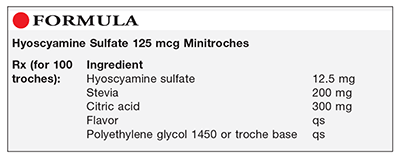US Pharm. 2015;40(8):47-48.

Method of Preparation: Note—Since molds vary in size, it is necessary to calibrate the mold being used to determine the quantity of polyethylene glycol 1450 or commercial troche base to be used in the formula.
Calculate the quantity of each ingredient for the amount to be prepared. Accurately weigh or measure each ingredient. Using low heat, heat the polyethylene glycol 1450 or troche base until it melts. Blend the hyoscyamine sulfate, stevia, and citric acid; mix well. Incorporate into the melted vehicle and mix until uniform. Remove from heat, add the desired flavor, and mix well. Pour into the selected minitroche molds. Cool, package, and label.
Use: This preparation has been used in the treatment of bladder spasms and the like.
Packaging: Package in tight, light-resistant containers.
Labeling: Keep out of reach of children. Discard after ____ [time period].
Stability: Refer to the current edition of the U.S. Pharmacopeia for the beyond-use date for this preparation.1
Quality Control: Quality-control assessment can include weight, specific gravity, active drug assay, color, texture of surface, appearance, feel, melting test, dissolution test, physical observation, and physical stability.2
Discussion: Hyoscyamine sulfate (Anaspaz, Levsin, Levsinex, (C17H23NO3)2.H2SO4.2H2O, MW 712.85) is an anticholinergic agent. It occurs as white, odorless crystals or as a crystalline powder. Hyoscyamine sulfate is deliquescent and affected by light. It is soluble 1 g in 0.5 mL water or 5 mL alcohol. The pH of an aqueous 1 in 100 solution is about 5.3. Hyoscyamine sulfate, which is a gastrointestinal anticholinergic and antispasmodic, is used as a bladder antispasmodic. It is the levorotatory isomer of atropine.3
Stevia (honey leaf, yerba dulce) powder is a relatively new sweetening agent. It is extracted from the leaves of the Stevia rebaudiana Bertoni plant. Natural, nontoxic, and safe, stevia occurs as a white, crystalline, hygroscopic powder. It may be used in both hot and cold preparations.4
Citric acid (citric acid monohydrate, C6H8O7.H2O) occurs as colorless or translucent crystals or as a white, crystalline, efflorescent powder that is odorless and has a strong, tart, acidic taste. It is present at about the 5% to 8% level in lemon juice. In 0.3% to 2% concentration, citric acid is used to improve flavor in liquid formulations and as a sequestering agent. It also may be used in the preparation of effervescent granules and in solid and semisolid (chewable) dosage forms. The hydrated form may contain up to 8.8% water, and the pH of a 1% w/v aqueous solution is about 2.2. Citric acid has a density of 1.542 g/mL. The hydrated form will effloresce and the anhydrous form will be hygroscopic, depending upon the humidity in the air. If stored in air that is too dry, citric acid may lose its water if the temperature reaches approximately 40°C. Its melting point is about 100°C, but it softens at about 75°C. One gram is soluble in <1 mL of water and 1.5 mL of ethanol. Citric acid is incompatible with potassium tartrate, alkali and alkaline earth carbonates, bicarbonates, acetates, and sulfides. If included in a syrup formulation, it may induce sucrose to crystallize from the syrup.5
Polyethylene glycol 1450 (Carbowax, PEG, polyoxyethylene glycol) is an addition polymer of ethylene oxide and water. At room temperature, it is a solid and occurs as white or off-white, waxy flakes. Polyethylene glycol has a melting point of about 44°C to 48°C, and it is soluble in water and miscible in all ratios with other PEGs. Polyethylene glycol is chemically stable, does not support microbial growth, and does not become rancid.6
Troche bases are available from a variety of sources that provide compounding supplies. Some are presweetened, in which case the stevia in the formula presented here can be omitted.
REFERENCES
1. U.S. Pharmacopeia 38/National Formulary 33. Rockville, MD: U.S. Pharmacopeial Convention, Inc; 2014:559-611.
2. Allen LV Jr. Standard operating procedure for performing physical quality assessment of suppositories, troches, lollipops and sticks. IJPC. 1999;3:56-57.
3. Allen LV Jr, ed. Remington: The Science and Practice of Pharmacy. 22nd ed. London, England: Pharmaceutical Press; 2013:1515.
4. Reynolds JE, ed. Martindale: The Extra Pharmacopoeia. 30th ed. London, England: Pharmaceutical Press; 1993:1049.
5. Amidon GE. Citric acid monohydrate. In: Rowe RC, Sheskey PJ, Cook WG, Fenton ME, eds. Handbook of Pharmaceutical Excipients. 7th ed. Washington, DC: American Pharmaceutical Association; 2012:193-196.
6. Wallick D. Polyethylene glycol. In: Rowe RC, Sheskey PJ, Quinn ME, eds. Handbook of Pharmaceutical Excipients. 6th ed. Washington, DC: American Pharmaceutical Association; 2009:517-522.
To comment on this article, contact rdavidson@uspharmacist.com.





